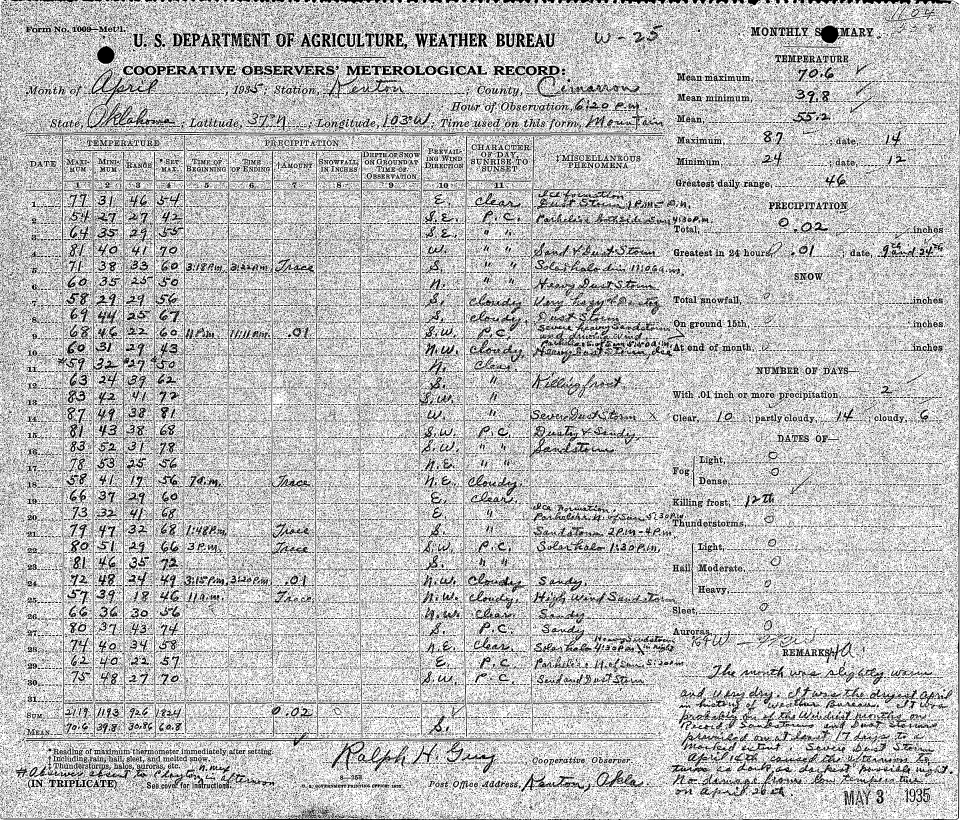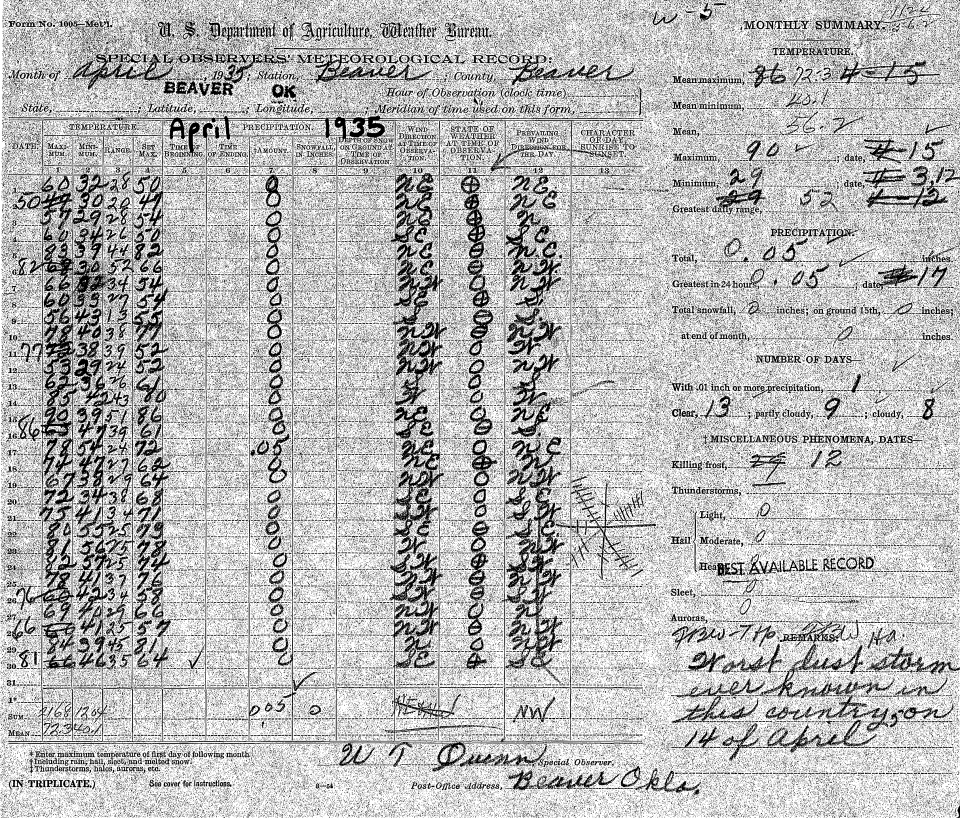Ticker for April 14, 2010
MESONET TICKER ... MESONET TICKER ... MESONET TICKER ... MESONET TICKER ...
April 14, 2010 April 14, 2010 April 14, 2010 April 14, 2010
Black Sunday Remembered
That Sunday 75 years ago in the Oklahoma Panhandle began magnificently with
bright sunshine, calm winds and plenty of spring warmth. Area residents, so
burdened by incessant dust that month, enjoyed the reprieve by flocking
outdoors. Picnics, car rides and odd jobs around the farm were tackled with a
renewed vigor. The region had suffered a significant dust storm just four days
previous on the 10th. It was as if the ?Dust Gods,? a term used by locals
during that period to embody the evil force behind their plight, had averted
their gaze from the beleaguered populace. The respite would prove to be
short-lived, however, and the calm was soon replaced with the violence of the
worst ?duster? of the Dust Bowl drought. The date was April 14, 1935, and will
be forever remembered as ?Black Sunday.?
Unlike the sand blows that occurred with the sirocco-like winds from the
southwest, the Black Sunday event was one of the less frequent but more
dramatic storms borne south on polar air originating in Canada. Rising some
8000 feet into the air, these churning walls of dirt generated massive amounts
of static electricity, complete with their own thunder and lightning. Reports
of the storm indicate that the cold air from the ?Norther? struck first, with
the wall of dust following soon thereafter. Temperatures plunged 40 degrees
along the storm front before the dust hit. Mr. Ralph H. Guy, National Weather
Service cooperative observer in Kenton, Oklahoma, noted about the storm:
?Severe dust storm hit at 4:20 p.m., turning afternoon brightness immediately
into midnight darkness, and absolutely zero visibility. It was totally dark and
impossible to see without searchlight, for at least 15 minutes?the storm came
from the north and northeast and traveled at a very great speed.?
On his official observer form, Guy remarked "The month was slightly warm and
very dry. It was driest April in history of Weather Bureau. It was probably
one of the windiest months on record. Sandstorms and dust storms prevailed on
at least 17 days to a marked extent. Severe dust storm on April 14th caused
the afternoon to turn as dark as the darkest possible night."
(I wouldn't swear to it, but it looks to me like he wrote a sarcastic "Ha!"
next to where it asks for remarks down on the bottom right)

Many area residents were caught unaware by this unique storm, remembered by
locals at the time as one of only three in living memory that appeared to
?roll? as it approached. Those caught out in the open were forced to crawl on
hands and knees in search of shelter in the impenetrable darkness, literally
unable to see their hands in front of their faces. Cars stalled and stopped in
the choking dust, and many thought the end of the world had come.
Here is a copy of the COOP observer from from Beaver for April 1935 ... note
the comment at the bottom right where official observer W.T. Quinn states
Worst dust storm ever known in this country, on 14th of April."

Associated Press reporter Robert Geiger and photographer Harry Eisenhand were
caught 6 miles north of Boise City, Oklahoma. The dust cloud enveloped their
car as they raced at 60 miles an hour in an attempt to outrun it. The trip the
rest of the way into Boise City took over two hours as they drove with the door
open so they could see the edge of the highway. A newspaper report by Geiger
the following day would give the era its name, a term eventually used as a
measuring stick for the severity of every drought thereafter.
In that report, Geiger wrote:
?Three little words?achingly familiar on a western farmer?s tongue?rule life
today in the dust bowl of the continent ... ?if it rains.??
Some survivors claim the term ?dust bowl? had been used by locals prior to
Geiger?s reports, an amalgam of the dust they were suffering and a soup bowl,
which was a familiar item due to the prevalence of Depression-era soup kitchen
lines. Nevertheless, the popularized term soon spread both nationally and
internationally.
Black Sunday storm seemed to mark the peak of the dust storms across the region,
although the dust would not stop with that most violent of storms. Several
stations in the Oklahoma panhandle reported moderate to heavy dust on 20 days
during the month, and light dust on other days. Other areas of Oklahoma were
not immune to the dust. The Oklahoma City Airport station noted dust on 18 days
during the month.
Black Sunday marked the turning point in the Federal Government?s recognition
of the soil erosion occurring in the Dust Bowl region, labeling it a ?national
menace.? Hugh Bennett, considered the father of the soil conservation movement,
had long tried to draw attention to the farmer?s plight. Up to that point, he
had been largely ignored, and the Dust Bowl was seen in the nation?s capitol as
just another facet of the depression. Already scheduled to deliver an address
to Congress concerning the matter, he heard tales of the massive Black Sunday
storm, spreading its dust towards the east. He stalled his report until the dust
settled over Washington D.C. Upon its arrival, many of the Congressmen were
horrified at the fine, powdery sand choking their throats and scratching their
eyes. Using the moment to full effect, Bennett proclaimed ?This, gentlemen, is
what I?ve been talking about.? On April 27th, 1935, the Soil Conservation
Service (SCS) was created, and placed under the control of Bennett.
To read more on the Dust Bowl, please see the Oklahoma Climatological Survey?s
?Summer 2004? edition of its seasonal summary series Oklahoma Climate:
http://climate.mesonet.org/seasonal_summary.html
Or visit the Norman National Weather Service office?s webpage at
http://www.srh.noaa.gov/oun/?n=blacksunday
And the Dodge City National Weather Service office?s webpage at
http://www.crh.noaa.gov/news/display_cmsstory.php?wfo=ddc&storyid=50702&source=0
Gary McManus
Associate State Climatologist
Oklahoma Climatological Survey
gmcmanus@mesonet.org
(405) 325-2253
April 14 in Mesonet History
| Record | Value | Station | Year |
|---|---|---|---|
| Maximum Temperature | 97°F | HOOK | 2003 |
| Minimum Temperature | 16°F | EVAX | 2022 |
| Maximum Rainfall | 3.12″ | GUTH | 2012 |
Mesonet records begin in 1994.
Search by Date
If you're a bit off, don't worry, because just like horseshoes, “almost” counts on the Ticker website!